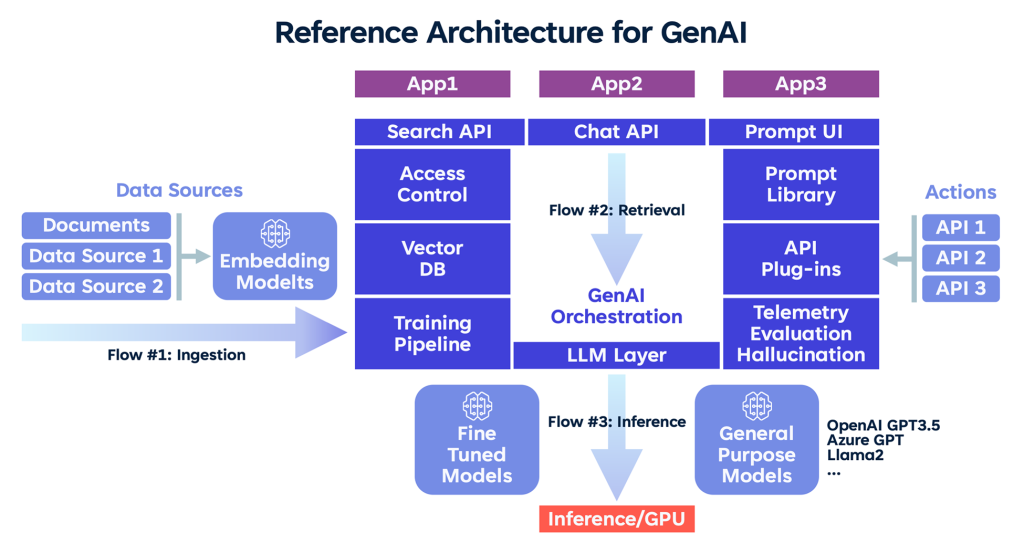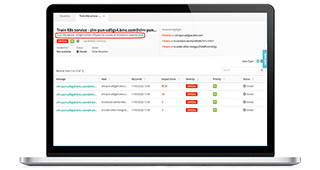This is the second blog in my series following “Requirements for Building an Enterprise Generative AI Strategy,” where I highlighted the significant challenges and expectations of enterprise customers for generative AI, with detailed requirements for building a strategy. My recommendations centered on being grounded in enterprise knowledge, integrating references for trust and verifiability, ensuring answers are based on user access control, and creating model flexibility.
In this blog, I introduce a reference ai model architecture designed specifically for generative AI applications, demonstrate how this architecture effectively addresses generative AI enterprise challenges around trust, data privacy, security, and large language model (LLM) agility, and provide a brief overview on LLM operations (or LLMOps). As a refresher, BMC HelixGPT is our approach to generative AI integrated across the BMC Helix for ServiceOps platform.
Generative AI reference architecture
An application architecture describes the behavior of applications used in a business, focused on how they interact with each other and users. It is focused on the data consumed and produced by applications, rather than their internal structure. The industry has long recognized three prominent AI design patterns to build generative AI applications:
- Prompt engineering
- Retrieval augmented generation (RAG)
- Fine tuning pipelines
Instead of debating which approach is better, BMC HelixGPT seamlessly integrates all three.
The generative ai architecture diagram below shows our BMC HelixGPT application reference architecture for generative AI. The architecture consists of several layers: API plug-ins, prompt library, vector data source ingestion, access processing control, model-training pipeline, and assessment layer to assess hallucination/telemetry/evaluations, a “bring your own model” embedding layer, and an LLM orchestration layer. BMC HelixGPT extensively uses LangChain as the engine to orchestrate and trigger LLM chains.

Reference Architecture for GenAI
The BMC HelixGPT proprietary generative AI technology, combined with LangChain open source models, provide “bring your own model” flexibility for our customers. There are also retrieval plug-ins, access control plug-ins, and API plug-ins that integrate into enterprise systems. Like the holistic design explained in this June 2023 blog by Andressen Horowitz, we have three main flows:
- Data ingestion and training flow: Data is read from multiple data stores, preprocessed, chunked, and trained through an embedding model (RAG) and training pipeline (fine-tuning). VectorDB stores the chunked document embeddings that allow for better semantic, similarity-based data retrievals.
- Prompt augmentation using data retrieval: Once a user query arrives at the API layer, the prompt is selected, followed by data retrievals through VectorDB or API plug-ins to get the right contextual data before the prompt is passed to the LLM layer.
- LLM inference: This is where there is a choice to use general purpose foundation models from OpenAI, Azure GPT models, or the self-hosted foundation model in BMC HelixGPT. Fine-tuned models are used when tuned for a specific task or use case. The response is evaluated for accuracy and other metrics, including hallucinations.
Now, let us look at how this reference architecture addresses the challenges of generative AI for enterprises and facilitates the rapid development of generative AI applications.
Overcoming common enterprise challenges with generative AI deployments
While the promise of generative AI systems are considerable, businesses face real challenges in deploying them. In thinking about what the challenges of generative AI architecture are, you will find that some are technical and operational, while others are ethical and societal, with a strong element of emotion thrown in.
Enterprise versus world knowledge: accuracy and trust
Enterprises seek answers across diverse internal and external enterprise data sources such as articles, web pages, how-to guides, and more. Further, data can be contained in both unstructured and structured databases. BMC HelixGPT ingests, chunks, and embeds these sources through LangChain data loaders using embedding transformer-based models. LangChain provides a rich set of document loaders that it leverages. When a user question is received, we augment the prompts with document retrievals from VectorDB or APIs and use the LLM’s in-context learning to generate a response. This method anchors the LLM’s response to the retrieved documents or data, reducing the risk of hallucinations. BMC HelixGPT also provides the retrieved documents as citations, allowing users to verify the responses. To realize this advanced capability, our strategy integrates various LangChain capabilities, such as retrieval QA chains with sources and conversation history chains.
Access control, security, and data privacy
During the retrieval of document flow, BMC HelixGPT validates that the user has access permissions to read the documents and removes those documents from the prompt context that the user doesn’t have access to. This ensures that LLM-generated answers are always from only those documents that a user has read access to. Hence, the same question will generate two different answers aligned to the user’s role and permission model.
Model flexibility and security
The BMC HelixGPT reference architecture is based on a model abstraction layer that LangChain provides. This capability enables seamless integration of foundational general-purpose models, whether hosted or behind APIs such as OpenAI and Azure or open-source models running in customers’ centers. There are over 50 connectors to different model providers in LangChain, making it easy to add new providers or models modularly. Customers who prioritize data security have the option to host and run a foundational model in the datacenter. This model architecture caters to diverse enterprise customers and prevents vendor lock-in, including implementations that provide the strongest privacy and security guarantees.
An Introduction to LLMOps
Machine learning for IT operations (MLOps) for LLM is called LLMOps. LLMOps is a new set of tools and best practices to manage the lifecycle of LLM-powered applications, including data management, model management, and LLM training, monitoring and governance LLMOps is the driving force to build generative AI applications for BMC HelixGPT.
BMC HelixGPT is a platform that provides models and services that allow applications to harness the power of generative AI. It also provides LLMOps foundational services such as prompt engineering and RAG to power a spectrum of use cases ranging from summarization to content generation and conversations.
LLMOps is distinct from MLOps because it introduces three new paradigms for training LLMs:
- Prompt engineering
- Retrieval augmented generation
- Fine-tuning pipelines
My third and final installment in this blog series will dive deeper into BMC HelixGPT’s LLMOps capabilities.
How to select a foundation AI model architecture
Selecting a foundation AI model architecture is a process of thinking through various factors and coming up with answers specific to your organization and situation. The list below covers some of the most important aspects of this decision.
1. Objectives and project needs
Consider the model’s ability to achieve the goals of your initiative and one that can handle the various tasks involved. BMC HelixGPT applies generative AI to service operations intelligence.
2. Cost considerations
How will the model fit your budget? Assess your options beyond the initial capital expense, to include maintenance and ongoing operational expenses. At BMC, we encourage you to calculate the ROI, not just the costs.
3. Privacy and cybersecurity
Security and compliance with laws and regulations around data privacy are vital. Investigate the capabilities of each model in handling confidential and sensitive information. BMC HelixGPT uses full encryption for data at rest and data in motion, role-based access, and is hosted at secure data centers around the world.
4. Ability to tailor to your needs
What tasks can be covered with off-the-shelf capabilities? Will you need customization, or the ability to modify and adjust the model? Choosing a configurable model like BMC HelixGPT allows you to tailor the model to your needs.
5. User support and community engagement
The strength of support you get from a vendor and an active, engaged community can add tremendous value. BMC HelixGPT, for example, includes full and accessible documentation, 24/7 world-class assistance, and educational content in the form of web-based training and self-service video tutorials. BMC also hosts an active community group where experts, enthusiasts, and users share ideas and help each other solve problems.
6. Ability to scale
As your business grows, the amount of data you collect grows, too, along with the complexity of the tasks your model must perform. A scalable model, like BMC HelixGPT, builds in extensibility with its cloud-native architecture, elastic resources, support of multi-tenancy, and the ability to integrate within your IT ecosystem with customizable workflows.
7. Compliance and ethical considerations
Keep in mind that you will need to make legal and ethical decisions, staying aware of potential biases in the model and your data. Beyond legal compliance requirements, you will want to consider ethical questions and build in safeguards that reflect your values.
8. Talent and outside resource availability
Ideally, you want to ensure you can find people with the skills to support your foundation AI model architecture. Talent is readily available for open-source models, but quality can be spotty. Closed-source, ready made solutions generally come with high-quality experts, but from a more limited talent pool. Training and skill development will need to be a priority in either case.
9. Long-term viability
Assess the vendor investment in development and support for any given model. You don’t want to be stuck with an orphaned platform. Given the pace of innovation, working with a company like BMC, which has a commitment over the long term, is protection for the viability of your investment.
10. Integration with existing systems
Make the most of your investment in your current infrastructure and avoid disrupting current workflows by choosing a foundation AI model architecture that integrates with your operational environment, like BMC HelixGPT. Ideally, your generative AI platform will enhance what you do, without throwing everything into disarray.







